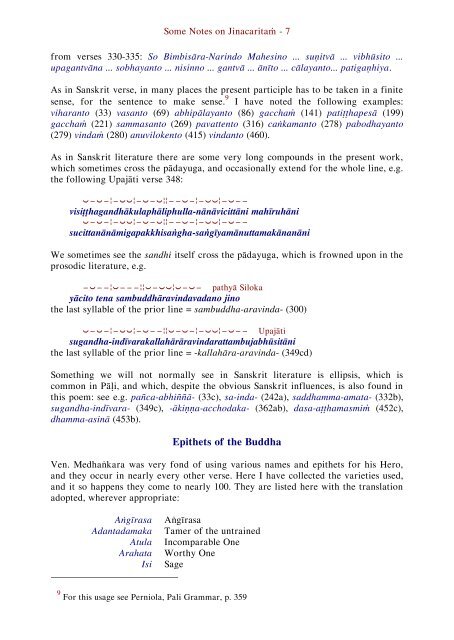Jinacaritaṁ: The Life of the Victorious Buddha
A Pāli and English line by line (interlinear) version of this Medieval verse biography of the Buddha from his Bodhisatta aspiration to the founding of the Jetavana monastery (together with extensive annotation).
A Pāli and English line by line (interlinear) version of this Medieval verse biography of the Buddha from his Bodhisatta aspiration to the founding of the Jetavana monastery (together with extensive annotation).
Create successful ePaper yourself
Turn your PDF publications into a flip-book with our unique Google optimized e-Paper software.
Some Notes on <strong>Jinacaritaṁ</strong> - 7<br />
from verses 330-335: So Bimbisāra-Narindo Mahesino ... suṇitvā ... vibhūsito ...<br />
upagantvāna ... sobhayanto ... nisinno ... gantvā ... ānīto ... cālayanto... patigaṇhiya.<br />
As in Sanskrit verse, in many places <strong>the</strong> present participle has to be taken in a finite<br />
sense, for <strong>the</strong> sentence to make sense. 9 I have noted <strong>the</strong> following examples:<br />
viharanto (33) vasanto (69) abhipālayanto (86) gacchaṁ (141) patiṭṭhapesā (199)<br />
gacchaṁ (221) sammasanto (269) pavattento (316) caṅkamanto (278) pabodhayanto<br />
(279) vindaṁ (280) anuvilokento (415) vindanto (460).<br />
As in Sanskrit literature <strong>the</strong>re are some very long compounds in <strong>the</strong> present work,<br />
which sometimes cross <strong>the</strong> pādayuga, and occasionally extend for <strong>the</strong> whole line, e.g.<br />
<strong>the</strong> following Upajāti verse 348:<br />
⏑−⏑−¦−⏑⏑¦−⏑−⏑¦¦−−⏑−¦−⏑⏑¦−⏑−−<br />
visiṭṭhagandhākulaphāliphulla-nānāvicittāni mahīruhāni<br />
⏑−⏑−¦−⏑⏑¦−⏑−⏑¦¦−−⏑−¦−⏑⏑¦−⏑−−<br />
sucittanānāmigapakkhisaṅgha-saṅgīyamānuttamakānanāni<br />
We sometimes see <strong>the</strong> sandhi itself cross <strong>the</strong> pādayuga, which is frowned upon in <strong>the</strong><br />
prosodic literature, e.g.<br />
−⏑−−¦⏑−−−¦¦⏑−⏑⏑¦⏑−⏑− pathyā Siloka<br />
yācito tena sambuddhāravindavadano jino<br />
<strong>the</strong> last syllable <strong>of</strong> <strong>the</strong> prior line = sambuddha-aravinda- (300)<br />
⏑−⏑−¦−⏑⏑¦−⏑−−¦¦⏑−⏑−¦−⏑⏑¦−⏑−− Upajāti<br />
sugandha-indīvarakallahārāravindarattambujabhūsitāni<br />
<strong>the</strong> last syllable <strong>of</strong> <strong>the</strong> prior line = -kallahāra-aravinda- (349cd)<br />
Something we will not normally see in Sanskrit literature is ellipsis, which is<br />
common in Pāḷi, and which, despite <strong>the</strong> obvious Sanskrit influences, is also found in<br />
this poem: see e.g. pañca-abhiññā- (33c), sa-inda- (242a), saddhamma-amata- (332b),<br />
sugandha-indīvara- (349c), -ākiṇṇa-acchodaka- (362ab), dasa-aṭṭhamasmiṁ (452c),<br />
dhamma-asinā (453b).<br />
Epi<strong>the</strong>ts <strong>of</strong> <strong>the</strong> <strong>Buddha</strong><br />
Ven. Medhaṅkara was very fond <strong>of</strong> using various names and epi<strong>the</strong>ts for his Hero,<br />
and <strong>the</strong>y occur in nearly every o<strong>the</strong>r verse. Here I have collected <strong>the</strong> varieties used,<br />
and it so happens <strong>the</strong>y come to nearly 100. <strong>The</strong>y are listed here with <strong>the</strong> translation<br />
adopted, wherever appropriate:<br />
Aṅgīrasa<br />
Adantadamaka<br />
Atula<br />
Arahata<br />
Isi<br />
Aṅgīrasa<br />
Tamer <strong>of</strong> <strong>the</strong> untrained<br />
Incomparable One<br />
Worthy One<br />
Sage<br />
9 For this usage see Perniola, Pali Grammar, p. 359


















